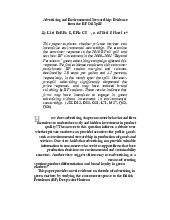







Preview text:
lOMoAR cPSD| 40799667
Lemelle 2009 - Race in International Relations
Advanced reading (Đại học Khoa học Xã hội và Nhân văn, Đại học Quốc gia Thành phố Hồ Chí Minh) lOMoAR cPSD| 40799667
International Studies Perspectives (2009) 10, 77–83.
ISP FORUM: RACE AND INTERNATIONAL RELATIONS
Race in International Relations TILDEN J. LE MELLE University of Denver
Any discussion of race, whether in intranational or international relations, requires a clear
definition of the term race and its derived concepts of racism and racial discrimination.
The term must also be distinguished from those words that too often are used
indiscriminately to mean race but have a distinctly differ-ent meaning and obfuscate any
serious attempt at understanding intra-national and international race relations. Primary
among such terms are a person’s eth-nicity and ⁄ or nationality to designate race.
Examples of the former are use of the terms African-American or Jewish. Examples of
the latter, though used less frequently, are such terms as Chinese race or Russian race.
Distinctions must also be made to understand the difference between racism and the
terms ethnocen-trism and nationalism. The former posits the inherent superiority of one’s
cul-ture over all others. The latter posits the nation-state as the ultimate and final
boundary for a citizen’s allegiance. Additionally, with the end of European colonialism
around the world, the elimination of legal anti-Black racial dis-crimination in the United
States and the defeat of Apartheid in South Africa, seemingly race-neutral terms have
emerged in domestic and international lexi-cons to designate race. Examples such as
inner-city, Western, the West, North-South, sub-Saharan Africa, and so on, all have racial
undertones beyond the superficially obvious geographical designation. As a matter of
fact, the almost universal use of the terms Western ⁄ Non-Western and the West not only
have racial undertones but posit Europe as the geographic center of the international
system. Hence, even in the present-day ‘‘global’’ international system, western Asia is
still defined from a European perspective, and northeasten Africa as well as Arabic
speaking states of the Maghreb are referred to as part of the Middle East. The case of
Israel as a ‘‘Middle East’’ state is interesting in that because of its Ashkenazi citizens and
the European origin of political Zionism, it is not always immediately perceived as a part
of southwestern Asia but as European despite its citizens’ historical and cultural
connection to the other Semitic people of the region. It is comparable to Australia and
New Zealand being counted as countries of the North in the discussions of North ⁄ South
issues as also in the establishment of the ANZUS treaty group (Brandt 1981).
Race has meaning only as a social phenomenon. The pseudoscience of the European
and U.S. physical anthropologists and other ‘‘scholars’’ has been totally discredited and
rejected. In that regard, the term race refers not to a species of humankind but to a group
of people who are socially defined on the basis of phenotypically similar (and dissimilar)
characteristics. Members of the group who are phenotypically dissimilar are usually self-
identified or are known to be descended from a phenotypiclly similar family inspite of
their own phenotypical dissimilarity. Through that biological connection phenotypically dissimilar
2009 International Studies Association
lO M oA R c P S D | 4 07 99 66 7 78
Race in International Relations
blacks are still socially defined as black. Although phenotypically blue eyed and blond,
Walter White, who headed the NAACP, was identified as a black man. Additionally,
depending on the somatic norm image (the generally identified phenotypical
characteristics of the majority of the members of the group) an individual who is
identified as a member of one racial group in one environ-ment may be identified in
another environment as a member of a different racial group. That is, a ‘‘white’’ person
in Brazil may be perceived to be a ‘‘black’’ person in the United States. The existence of
two or more racial groups in a society presumes the existence of racism since without
racism there would be no social basis for differentiation. As Pierre L. van den Berghe
states in his seminal work, Race and Racism (Van Den Berghe 1967), ‘‘It is not the
presence of objective physical differences between groups that creates races, but the
social recognition of such differences as socially significant or relevant.’’ Racism—Origin
Racism is the ascription of assumed superior ⁄ inferior status to members of physi-cally
identifiable groups solely on the basis of their biologically inherited physi-cal differences
or, if phenotypically dissimilar, on their known descent from a group so identified (Le
Melle 1971 in Burkey). The corollary of this assumed inherent superiority is the a priori
right of the superior race to access to society’s rights and privileges and to dominate the
inferior to maximize the racists’ values and interests. As such racism is a relatively
modern phenomenon and unlike eth-nocentrism is not and has not been a universal value
in all societies. While it has appeared in some physically distinguishable multiethnic
small societies, racism as a worldwide ideological and mythological phenomenon
impacting the lives of millions of peoples and shaping the structure and function of the
international system is the creation of 18th and 19th century Europeans. Many are the
mythol-ogies spawned by racism about non-Europeans—the indigenous peoples domi-
nated by Europeans. Those mythologies reinforced racist stereotypes created to support
historical, theological, and pseudoscientific theories about race and are best left for the
reader interested in sick humor. They are reflective of the igno-rance, prejudice and fears
of the myth makers and not the true qualities of the targets of their racist ridicule and
aversion. The myths, however, did serve to support racism as an ideology giving
legitimacy to racist domestic and interna-tional policies (Le Melle in Shepherd and Le Melle 1970, x–xiv). Racism as Ideology
It is as national ideology that racism has played its most important role in mod-ern
international relations. As a conscious ideology—as a means for justifying national
policies—racism developed hand in hand with the 18th and 19th cen-tury expansionist
thrust of Europe into other parts of the world. Whether expressed as the civilizing mission
or the Christianizing mission or simply as the inherent right of a superior people, it
provided the justification for the effort by Europeans to extend and maintain their
domination in those lands that fell sub-ject to European imperialism. Paradoxically, this
era of expansionism occurred simultaneously with the period that produced western
Europe’s and the United States’ greatest and most noble pronouncements on the equality
of man. Yet this same period produced what some consider one of the darkest chapters in
the history of man’s inhumanity to man.
It was not, however, until the latter part of the 19th century that the arguments in
support of the inequality of races were systematized into what might be called an official
ideology. In the United States, this occurred as a result of the attempt to justify the
enslavement of black skinned Africans and lOMoAR cPSD| 40799667 TILDEN J. LE MELLE 79
of the post 1876 discriminatory Jim Crow laws designed to reduce the black American to
his former position of subservience. Endless were the claims that the black American was
of a naturally inferior race, suited only for servitude. A pseudoscientific base was sought
in the concepts of Charles Darwin. Social Darwinism equated the principle of survival of
the fittest with the right of the fittest to rule. Naturally the white race was the fittest. The
enslavement and conquest of non-white peoples was propagated as evidence of the racial
superi-ority of white peoples. Governor J. H. Hammond of South Carolina brought the
ideology to an extreme in his ‘‘mud sill’’ theory which argued that in all societies there
must be a class to do the menial tasks. The class at the bottom of the political,
socioeconomic ladder was necessary for the progress of the upper classes. To him, of
course, that class was the African American. The Civil War decided the issue of slavery,
but racism remained as a part of the American ideology.
In Europe, as a means for justifying imperialism in Asia and Africa, racism developed
as an inherent part of national ideologies. Through the early efforts of ethnologists to
classify peoples of the world according to biological character-istics, there developed
among social scientists (who were even then concerned about their lack of a scientific
frame of reference) a tendency to view ‘‘race’’ as the all-pervasive explanation for social
behavior and institutions. The racist implications of anthropological terms such as
brachycephalic (broad skulled) and dolichocephalic (narrow-skulled) or the attempt to
attribute the assumed sexual and athletic prowess of black women and men to racial traits
are products of the attempt to systematize and intellectually legitimize racist ideology.
The effects of these efforts persist today in some of the popular literature of European
dominant societies and reflect psychocultural phenomena primarily unique to those
societies (Kovel 1970; Marimba 1996).
Extremely influential in the modern development of racism as ideology was Count
Arthur de Gobineau (1853–1855), French aristocrat, litterateur, and dip-lomat. It was he
who first formulated the Aryan myth—the idea that all human characteristics were
determined by race and that white people descended from a superior race, the Aryas. The
Aryas, he contended, were no longer pure, but some of their miscegenated descendants
still carried enough Aryan blood to claim the right to rule. These descendants were the
aristocrats of the white nations. Thus social superiority was to be determined in terms of
whiteness. After classifying and grading shades and hues of white, there was not much of
value left to be attributed to the brown or yellow or the black races—the black being at
the bottom of the color scale.
De Gobineau’s ideas were especially welcomed by such Nordic racists as Nietzsche
and Schopenhauer and the composer Richard Wagner. It was the Englishman Houston
Stewart Chamberlain, however, who crystallized the ideas for use in German
nationalism. Since he and Hitler were very close friends and he married Wagner’s
daughter, one can imagine the mutually satisfactory con-versations that must have taken
place among them on the subject of race. The culmination of racist ideology in Europe in
the oral and written raving and rant-ing of Hitler is common knowledge. Hitler, however,
was but the Frankenstein monster turned upon its creator (Le Melle in Shepherd and Le Melle 1970).
Racism: Racial Discrimination as Foreign Policy
The enunciation of racist beliefs and ideologies was not by itself a sufficient cause for the
implementation of the domestic and international racist policies that informed the
relationship between Europeans and the non-Europeans with whom they came in contact.
Nor were the European desire and perceived need for the goods and services of non-
Europeans a sufficient cause. Racism may lead
lO M oA R c P S D | 4 07 99 66 7 80
Race in International Relations
to attitudes of dislike and distrust but not necessarily to racially exclusive behav-ior
reflective of those attitudes. It may lead to feelings of hostility and antipathy for
members of another racial group, but even this is insufficient to bring about racial
discrimination. If a racist group is to translate racial biases and prejudices into racial
discrimination ( Jim-crow, code noir, colonization), it must be politi-cally and
economically dominant. Accordingly, it was also in the 18th and 19th centuries that
European political and economic power converged with the devel-opment of European
racist ideologies. Western Europe in particular, having been left out of the world of the
great ancient civilizations of Africa and Asia and cut off for centuries from the direct
influence of what remained of Hellenistic and Roman civilizations of the central
Mediterranean and western Asia, emerged as dominant powers in the world. The
beginning of the emer-gence of Western European power can be dated to the 16th and
17th centuries as Europeans sought to find trade routes to Asia around the blockades set
up by the Muslim powers to the East. The ability to dominate the fragmented traditional
states of the non-European world, however, actually culminated in the mid nineteenth century.
Buoyed up by their assumption of superior rights based upon their assump-tion of
racial superiority, Europeans set out to impose white rule over the whole world.
Although they were seeking primarily political and economic gain, they justified their
conquest of the nonwhite peoples of the world in terms of nature and religion. The result
was what became known as the color line in the colonial situation (Gardiner 1968). Many
attempts have been made to distinguish between French and British colonial policies in
particular, but the facts do not support a significant difference on the question of race.
Both policies assumed the inherent racial inferiority of the nonwhite. The official French
policy of assimilation or identity provided that the nonwhite colonized peoples could
become black, brown or yellow Frenchmen provided they rose above their own racially
spawned inferior culture and assimilated the univer-sally superior civilization of the
French. Among the British the same policy was expressed through Cecil Rhodes’s
famous slogan: ‘‘Equal rights for all civilized men.’’ Neither policy worked. The French,
after a brief experiment in Senegal, could not bring themselves to accept the logic of
practical assimila-tion-racial equality; the bloody consequences of racism in Cecil
Rhodes’s southern African empire are all too well known. All European powers resorted
to what has been called the policy of association: the nonwhite could associ-ate with
European as a ‘‘hewer of wood’’ but never as an equal. The con-tradictions of actual and
de facto segregation in the United States and of South Africa’s apartheid were that both
systems were in fact nothing more than association on an unequal basis. The policies of
Europeans in the New World toward the indigenous peoples in many cases amounted to
geno-cide—the elimination of whole peoples and cultures and forceful taking of land in
the name of Christianity and country—the civilizing mission which was equated with the
Christianizing mission.
The same assumptions of the racial inferiority of nonwhites underlay the Lea-gue of
Nations Mandate system that gave formal international legitimacy to the colonial
situation. The ABC Mandate System legally established the white nations of the world as
the arbiters of when the nonwhite peoples were considered suffi-ciently civilized to
govern themselves. The irony, of course, is that those peoples had governed themselves
well before the European intrusion. The Mandate System was interesting in that the
categories of self-government readiness it projected conformed to the colonialist and De
Gobineauan assumptions of gra-dations in racial inferiority. Representative of this was the statement of George
Hardy, one-time director of the French _ . Speaking of the need to E cole Coloniale
adjust colonial policy to the degree of backwardness of a country he said: lOMoAR cPSD| 40799667 TILDEN J. LE MELLE 81
‘‘Differences in (the colonial) situations demand differences in approach: one does not
handle a literate Vietnamese or Moroccan as he would a savage of Cen-tral Africa or
Australia.’’ That is, all nonwhites are inferior beings, but the black African is even more
inferior—at the bottom of the De Gobineauan human scale (Le Melle in Shepherd and Le Melle 1970).
It is not difficult to understand the racist assumptions behind the Mandate System
when one considers the strong opposition to and eventual rejection of Japan’s proposal
for unreserved acceptance by the European powers of the prin-ciple of racial equality.
Great Britain and France especially regarded Japan’s request as a challenge to the
superiority of white people, and the U.S. President Wilson, even though he supported
Japan for a while, found that he could not buck racism in the United States. He joined in
rejecting Japan’s proposal. Thus, not only in the Mandate System but in their refusal to
support the principle of racial equality, the white European powers of the League of
Nations and the United States sanctioned racism in international relations. The principle
of self-determination enunciated in the Fourteen Points meant that the white powers
would decide when the nonwhite peoples of the world could be free to direct their own lives.
It is no wonder, then, that Hitler’s racial policies were so successful or that South
Africa could defy the world in pursuing racist policies not only at home but in Mandated
Southwest Africa (Namibia) or that Rhodesia’s Unilateral Declaration of Independence
could openly defy the authority of Great Britain in the name of white supremacy (Le
Melle in Shepherd and Le Melle 1970).
Racism has manifested itself internationally not only through European colonialism
and in international organizations but also in immigration policies. The 1870 U.S.
immigration law discriminating against Chinese and Koreans, the 1906 Gentlemen’s
Agreement and the 1924 Johnson Immigration Act directed against the Japanese, the
general discrimination against the Mediterranean darker-skinned European (Italians were
classified as black in Mississippi)—all represented the noisome poison of racism and
color prejudice. One might also cite Australia’s 1901 law against those who could not
write a European language or Canada’s 1908 law restricting Japanese immigration or
South Africa’s Apartheid restriction against non-European immigration. The Japanese
had to be given, and accepted, the title of honorary white to be allowed into South Africa for business activities.
One would think that fighting a war in the name of democracy and against the evils of
racial and ethnic bigotry of Hitler’s Nazism would have dimin-ished if not excluded
racism from the foreign policies of states dominated by Europeans and their descendents.
The U.S. incarcerated Japanese Americans and not white German Americans while
continuing racial discrimination and separation in the military. Europeans continued to
try to maintain control over their colonial subjects even to the point of using military
force. The establishment of NATO, the North Atlantic Treaty Organization, for defense
against the threat of postwar Communism, only included north Atlantic states controlled
by whites. So-called associated states like Australia and New Zea-land were in the South
Pacific. The majority of states located in the North Atlantic were and still are populated
predominantly by black and brown peoples and today are governed by those people. The
Korean War, the Vietnam War, and the initial decision to exclude a billion Chinese from
representation in the United Nations reflected more than anticommunism. The Soviet
Union, after all was the bedrock of communism in the world. U.S. Secretary of State
Dean Rusk’s preoccupation with the threat of ‘‘the yellow peril ’’ during the Vietnam
War was as much a representation of the mind set of U.S. foreign policy makers and the
U.S. soldiers’ ‘‘gook’’ mentality as was the concern with communism.
lO M oA R c P S D | 4 07 99 66 7 82
Race in International Relations
Racism: Dysfunctionalism and Revolutionary Change
The function of European racism and racial discrimination resulted in the crea-tion of
white dominant racially stratified societies in the colonized indigenous lands they
dominated (Halpern 1969). The analysis of the structure and function of European
domination reveal that the ‘‘new order’’ was ultimately designed to maximize the values
and interests of the colonizer. Such societies ⁄ systems, how-ever, are inherently
dysfunctional in all respect for their subordinate racial groups and, hence, include the
seeds of their own eventual self-destruction. The ideology of white supremacy and the
practice of racial discrimination initially functioned as a centripetal force holding white
dominant systems together (Le Melle and Shepherd 1971). Those same forces, however,
gave rise to the further awakening of race consciousness among people where such
consciousness had never existed before. That race consciousness (pro-self ⁄ not anti-
other) derived from the realization that becoming an assimile, an assimilado, or a proper
black ⁄ brown Englishman did not bring the expected reward of equality for the subordi-
nate native. The race barrier remained intact. Equality had to be won on one’s own terms.
Winning meant struggle against the conqueror. That struggle resulted eventually in the
establishment of new states in Africa and Asia as part of the world reaction to racialism.
It meant the development of other ideologies in terms of race. The concepts of Negritude,
African Personality, Afro-Asian solidar-ity, Pan-Arabism, Pan-Africanism—all were in
large measure a race conscious response to the ideology of white supremacy and racist
policies. It meant that mainland China could speak to a receptive audience at the
Bandung Conference in 1955 in terms of the colored peoples of the world uniting against
the white and imperialistic minority in a predominantly nonwhite world. It meant that the
United States in the Vietnam War was often portrayed as a white power trying to avenge
the defeat of a white European colonial power by a weak but determined little yellow
nation. It meant the ultimate revolt of subordinate people of color against white
domination throughout the entire colonial world and in the United States leading to
political independence, democratic majority rule in South Africa, and civil rights
legislation in the United States.
Needless to say, just as racism without power does not lead to racial discrimi-nation,
the race consciousness that informed the liberation movements among nonwhite peoples
was not sufficient in itself to bring about change in the rela-tionship between white
dominant rulers and their non-white subordinates. That race consciousness had to be and
was supported by the increasing ability (power) of subordinate groups to increase the
cost of continued domination. However, given the nature of a racially stratified system—
race and class are inherently co-terminous, the change in the relationship between non-
white subordinates and their former colonizers was but a change in the condition of their
subordinate position-not a change in their position as subordinates (Le Melle in Burkey
1971). The domestic struggle for equality moved more directly into the international
system and continues today. Except for China and Japan whose political and economic
power capabilities have increased sufficiently to play a dominant role in international
affairs, the non-white peoples of the world still occupy a subordinate position in world
affairs. The patterns of stratification that had existed domestically in colonial times
continue today in the international system. The Security Council of the United Nations,
the International Monetary Fund, the World Bank, the World Trade Organization
(replacement for GATT), the world hard currencies controlling world trade—all are
dominated by the white dominant powers and function to maintain racial stratification in
the international system as had existed in the domestic colonial situation.
At the beginning of the 20th century, W. E. B. Dubois enunciated his prophetic
pronouncement: ‘‘The problem of the 20th century is the problem of lOMoAR cPSD| 40799667 TILDEN J. LE MELLE 83
the color line—the relation of the darker to the lighter races of men in Asia and Africa, in
America and the islands of the sea’’ (Foner 1970). The 20th century has passed into the
21st century and the problem of color in domestic and international relations still
remains. Colonialism has been defeated; fascism and communism have come and gone
except for nominal remnants of the latter in Cuba, China, and Vietnam. Nineteenth and
early 20th century nationalistic capitalism is being replaced with transnational global
capitalism; China, a non-white state, is on its way to becoming the number one world
power; India is on its way. The international system remains still a white dominant
racially stratified system. Will economic globalism and the imperative of transnational
interdepen-dency break down the barriers of racial stratification? Will the white
dominant powers peacefully accept a diminution of their position in the international
system? Will the non-white emerging powers be content to accept only a change in the
condition of their subordinate position? Or will the transformation of the international
system be achieved through violence as the case was in the transformation of the national racially stratified systems? References
ANI, MARIMBA. (1996) Yorugu, An African-Centered Critique of European Cultural Thought and Behavior, 6th
printing, Trenton, NJ: Africa World Press.
BRANDT, WILLY. (1981) North-South, 6th printing, Cambridge, MA: The MIT Press.
FONER, PHILIP S, ED. (1970) Address to the Nations of the World, W.E.B. Dubois Speaks. pp. 124–127, New York: Pathfinder Press.
FRANKLIN, JOHN HOPE, ED. (1968) Color and Race. Boston: Houghton Mifflin Co.
GOSSETT, THOMAS F. (1973) Race: The History of an Idea in America. Dallas, TX: Southern Methodist University Press.
HALPERN, MANFRED. (1969) Applying A New Theory of Human Relations to the Comparative Study of Racism.
In Studies in Race and Nations, edited by Tilden J. Le Melle, Vol. 1, No 1. Denver, CO: Center on Race
in International Relations, GSIS, Denver University.
KOVEL, JOEL. (1970) White Racism: A Psychohistory. New York: Pantheon Books, Random House.
LE MELLE, TILDEN J. (1970) Public Policy and Anti-Black Discrimination in the United States. In Report on the
International Research Conference on Race Relations, edited by George W. Shepherd, Jr. and Oscar
Schacter. pp. 132–143, Aspen, CO: UNITAR, CIRR, Aspen Institute.
LE MELLE, TILDEN J. (1971) Foreword in Richard M. Burkey Racial Discrimination and Public Policy in the
United States, pp. ix–xvii. Lexington, MA: D.C. Heath and Co.
LE MELLE, TILDEN J., AND GEORGE W. SHEPHERD JR. (1971) Race in the Future of International Rela-tions.
Journal of International Affairs Vol. XXV, Number 2, 302–314, New York: School of Interna-tional Affairs, Columbia University.
SHEPHERD, GEORGE W. JR., AND TILDEN J. LE MELLE. (1970) Race Among Nations: A Conceptual
Approach. Lexington, MA: Heath and Co.
VAN DEN BERGHE, PIERRE L. (1967) Race and Racism: A Comparative Perspective. New York: John Wiley and Sons, Inc.





